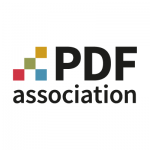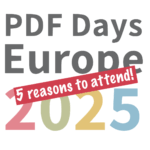Discover the Future of Print Product Metadata with ISO 21812-1

The PDF Association staff delivers a vendor-neutral platform in service of PDF’s stakeholders.


In the ever-evolving landscape of print technology, the ability to communicate detailed print product requirements efficiently and accurately is crucial. Enter the Print Product Metadata (PPM) ISO standard (ISO 21812-1), a groundbreaking innovation that leverages the capabilities of PDF features introduced in ISO PDF/VT and the native support in PDF 2.0.
This new Application Note from the PDF Association's Print Product Metadata Liaison Working Group document provides an essential overview and technical introduction to PPM, highlighting its potential to revolutionize the way finished print products are described and communicated.
What is Print Product Metadata (PPM)?
 PPM is structured, machine-readable information embedded within a PDF file, describing the characteristics of a finished print product in relation to the PDF pages. This detailed metadata ensures that print product requirements are conveyed accurately across various stakeholders in the print ecosystem—from designers and buyers to prepress professionals and production teams.
PPM is structured, machine-readable information embedded within a PDF file, describing the characteristics of a finished print product in relation to the PDF pages. This detailed metadata ensures that print product requirements are conveyed accurately across various stakeholders in the print ecosystem—from designers and buyers to prepress professionals and production teams.
The Power of PDF with PPM
PDF files are already the standard for specifying final page content for print applications, known for their ability to handle everything from simple black-and-white graphics to complex, color-managed designs. However, while the family of PDF/X standards establishes rules for representing page content for print purposes, they don't describe the specific requirements of the finished print product. This is where PPM steps in, bridging the gap and providing a comprehensive solution, especially when used with PDF/X-6 (PDF/X for PDF 2.0).
Key Features of PPM
- Integration with PDF 2.0: Leveraging the advancements of ISO 32000-2 (PDF 2.0), PPM can embed structured metadata within the PDF file itself, ensuring all necessary details about the finished print product are included.
- Detailed Product Descriptions: PPM allows for the detailed description of print products, covering aspects such as paper type, binding styles, and specific page requirements. This ensures that every aspect of the print product is accounted for within a single, unified file.
- Uniform and Variable Data Printing: In variable data printing scenarios (such as those using ISO PDF/VT), PPM can describe both uniform and varied finished product requirements per recipient, aligning with the varied page content.
Modernizing Print Communication
Before PPM, the print industry relied on a mix of ad-hoc methods, including emails, customer service representatives, and online portals, to communicate finished product requirements. These methods often led to miscommunication and inefficiencies. PPM standardizes this process, embedding all necessary information within the PDF file itself. This standardization reduces the potential for errors, streamlines communication, and ultimately lowers costs.
Compatibility and Interoperability
One of the most significant advantages of PPM is its compatibility with existing graphic design, MIS, prepress, and production workflow tools that support PDF. This ensures that PDF files containing PPM metadata can be read, viewed, and edited by any supporting application. For instance, a bound book's details—cover type, body sections, folded pages, etc.—can all be precisely defined and easily interpreted by downstream software.
A Non-Proprietary Solution
The PPM standard is based on the CIP4 XJDF specification, specifically the subset known as Product Intent. This ensures that PPM is a non-proprietary means of specifying finished print product definitions, making it portable and interoperable among software systems from different vendors.
Conclusion
By embedding detailed, machine-readable metadata within PDF files, PPM provides a robust solution for communicating print product requirements efficiently and accurately. This innovation not only modernizes the print communication process but also paves the way for improved collaboration and reduced costs across the print ecosystem.
For software developers and stakeholders, understanding and adopting the PPM standard is essential for staying ahead in the competitive print industry.
Get the Application Note
Download the PDF Association's Application Note for PPM today, and explore the full potential of PPM to drive a more streamlined and effective print production process. There's no cost; not even a signup form.




